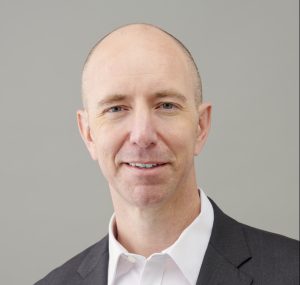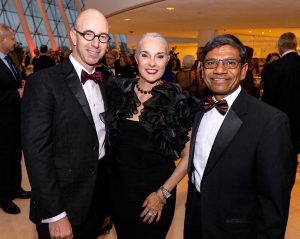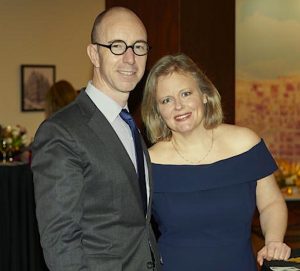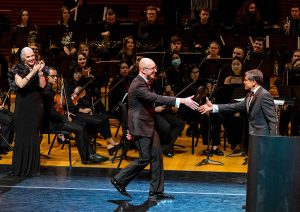After more than two decades and four deans, it was beginning to look as if the UMKC Conservatory’s dream of a new facility would remain just that: a dream. Until now, that is.
“This fall, Dean Courtney Crappell will reveal exciting plans for several phases of renovations and expansion of the Conservatory to meet future needs,” said University of Missouri-Kansas City Chancellor Mauli Agrawal, in an astonishing announcement during his annual State of the University Address this April. “We will then launch fundraising efforts for those changes.”

Courtney Crappell began his duties as Dean of the UMKC Conservatory in August 2022.
The timing of this long-awaited, game-changing development could hardly be better. With UMKC Theatre having become part of the Conservatory (in 2019), a new facility now makes perfect sense, both financially and from a programming standpoint.
“It’s remarkable to look back at the history and think about all of these factors lining up and leading to this moment,” said Courtney, who was previously director of the University of Houston’s Moores School of Music and associate dean for that school’s College of the Arts. “The pieces are all there, the game is set, and right now we have to play it to win.”
In addition to the establishment of theater as the “third pillar” for the Conservatory’s divisions of music and dance, the gaining of new knowledge about strengths and limitations of online instruction during the pandemic have aided in future programming for the facility. “We now have a better understanding of what our work in arts education will be like in the next decade,” Courtney said. “Across the nation, leadership in the arts has recalibrated based on what we learned.”
Courtney’s experience in leadership at a large urban-serving university is just what the Conservatory needed to foster its increasingly cosmopolitan profile. In Houston, he led a variety of fundraising campaigns, expanding the Moores School’s endowment and raising more than $10 million for scholarships, chairs, and program support. He also forged bonds with Houston’s vast medical community, creating interdisciplinary programs and laying the foundation for the Moores School’s first music therapy program.
Courtney knows arts instruction and academic life from the inside. After earning his doctor of musical arts degree from the University of Oklahoma, he taught piano at the University of Texas-San Antonio before moving to Houston. In addition to more than 50 articles for scholarly journals, he has authored what is probably the definitive book on modern piano pedagogy, published by Oxford University.
Recently we sat down with Courtney to chat about his past, present, and future. We excerpt some of that discussion here.

Dean Courtney Crappell, Michele Hamlett-Weith, event chairman; and UMKC Chancellor Dr. Mauli Agrawal at the 2022 Crescendo event.
On being raised in the heart of Cajun country, and on his first visit to Fabregas Music Store on Main Street in downtown Houma, Louisiana:
My interest in the arts started from having music around me constantly as a kid. My Dad played guitar, and we played music and sang together at home. … Music was where joy happened, it was where family happened. It connected me to something much larger than the hand-to-mouth existence I knew so well in my life growing up in south Louisiana.
When I heard a piano for the first time at that music store, I thought it was the most magical sound I had ever heard in my life. Something clicked. I then looked around and saw that some people were teaching piano for living, that was their actual job. I thought, maybe I could do that, and I started working to go to Louisiana State University as a piano major. … Believe it or not, I had never even heard a solo classical piano concert, not to mention a symphony, until I went to LSU.
As an undergraduate and then a graduate student, the academic world was like a utopia that I never realized existed before. It’s not perfect. … But it was a fantasy for me, and it still is to this day: a place where we come to strive for the next level, to push human boundaries through a quest for knowledge, through education and research. Since my first undergraduate class on campus, I immediately became enamored of the academic world: and I never left!

Dean Courtney Crappell and Conny Crappell were celebrated at the Friends of Chamber Music’s Soirée 2023 benefit.
On looking past traditional conservatory training:
There’s so much we can be doing that is beyond this almost binary type of arts education, which is often focused on performance training or teacher training. In fact, with only those two aspects in mind, I believe we are leaving a lot of the population behind that we shouldn’t. … Think about that high school piano student who says: Well, I can’t play this Chopin étude for the audition that’s required to get into music school, so I guess I’m going into business.
Maybe that student was the next dean of the Conservatory, and never had a pathway into the arts? … If we could find those pathways, perhaps through broader curricula or even interdisciplinary opportunities, we’re going to open more doorways to people who were not engaging in the art forms professionally before.
On why he liked the prospect of coming to Kansas City:
This job piqued my interest for a very specific reason: Because I looked at this Conservatory and was impressed at how well it was tied to the community. … The Conservatory was the feeder, the pipeline for the arts in this community. The Kansas City Symphony exists because of it, the Kansas City Chorale, KC Rep, Kansas City Ballet. So much exists because the Conservatory was here to bring that talent to Kansas City and foster it within the area.
Also, I saw that the need for new facilities had not gone away, and that became a second main factor in my interest in the Conservatory. When I looked at this project, it looked like a challenge I wanted to take on. And I believed that if I could help the community understand the value we offer, we could start this project that has been discussed for such a long time. I wanted to be a part of making this dream a reality.

Dean Crappell greeted Chancellor Mauli Agrawal at the 2022 Crescendo.
On getting ready for this fall’s big announcement:
As the Chancellor mentioned in his spring address, we’re planning a two-phased approach to a capital campaign. In phase 1, we would increase our square footage through a sizable expansion, then phase 2 would include substantial renovation. Rest assured, this work will have a huge impact on all of the Conservatory’s divisions. It will transform our facilities for theater, dance, and music.
When I originally contemplated a launch for the project, I imagined having to do more groundwork, but when I got here, everybody I spoke to was ready for something to happen. There was a hunger for it in the community. It will still take us some time to go public with the campaign, since we want to be completely prepared, and also to work with our major stakeholders in advance of the announcement. That’s work I’m doing right now. I assure you, though, we’re well on our way!
To reach Paul Horsley, performing arts editor, send an email to paul@kcindependent.com or find him on Facebook (paul.horsley.501) or Twitter/Instagram (@phorsleycritic).